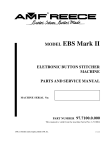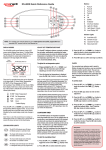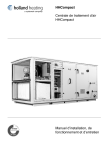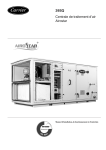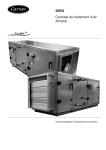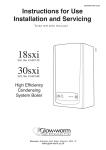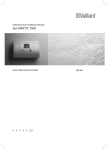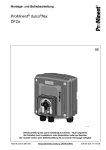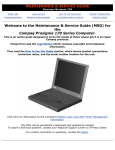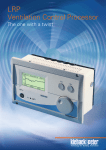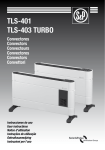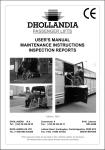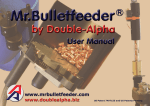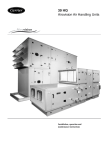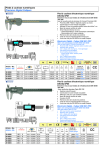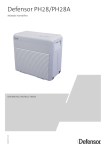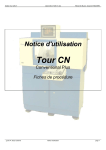Download HHFlex HHFlex Air Handling Units Installation, operation
Transcript
HHFlex HHFlex Air Handling Units Installation, operation and maintenance instructions Contents 1 - SAFETY considerations ............................................................................................................................................... 4 1.1-General......................................................................................................................................................................................... 4 1,2- Applications ............................................................................................................................................................................... 4 1.3 - Instruction types........................................................................................................................................................................ 4 1.4 - Disposal of parts/materials....................................................................................................................................................... 6 2 - Transport AND LIFTING INSTRUCTIONS................................................................................................................ 6 2.1 - General ...................................................................................................................................................................................... 6 2.2 - Transport and storage............................................................................................................................................................... 6 2.3 - Roof edge protection during transport (outside installation) ............................................................................................. 6 2.4 - Offloading and hoisting............................................................................................................................................................ 7 2.5 - Horizontal transport................................................................................................................................................................ 7 2.6 – Storage....................................................................................................................................................................................... 7 2.7 – Assembly................................................................................................................................................................................... 7 3 - CHECKLIST OF START-UP CHECK POINTS.................................................................................................................. 9 3.1 - Checklist of start-up check points........................................................................................................................................... 9 4 - START-UP INSTRUCTIONS................................................................................................................................................. 11 4.1 - Casing ...................................................................................................................................................................................... 11 4.1.1 - Casing panels........................................................................................................................................................................ 11 4.1.2 - Doors and access covers...................................................................................................................................................... 11 4.1.3 - Flexible connections............................................................................................................................................................ 11 4.1.4 - Earthing................................................................................................................................................................................. 11 4.1.5 - Connected ducts................................................................................................................................................................... 11 4.1.6 - Outdoor air intake............................................................................................................................................................... 12 4.1.7 - Assembly and placement of the air handling unit............................................................................................................ 13 4.1.8 - Air contamination................................................................................................................................................................ 13 4.1.9 - Condensation in or on the AHU........................................................................................................................................ 13 4.2 - Dampers................................................................................................................................................................................... 13 4.2.1-Dampers.................................................................................................................................................................................. 14 4.2.2- Recirculation dampers.......................................................................................................................................................... 14 4.3 - Air filters.................................................................................................................................................................................. 14 4.4 - Heaters..................................................................................................................................................................................... 14 4.4.1 - Hot water coil....................................................................................................................................................................... 14 4.4.1.1 Coils containing glycol..................................................................................................................................................... .. 15 4.4.2 - Electric heater....................................................................................................................................................................... 15 4.4.4 -Steam heaters......................................................................................................................................................................... 15 4.5 - Coolers...................................................................................................................................................................................... 16 4.5.1 General.................................................................................................................................................................................... 16 4.5.2 - Glycol in elements, see 4.4.1.1............................................................................................................................................ 17 4.5.3 – DX-coils................................................................................................................................................................................ 17 4.6 - Heat recovery wheel............................................................................................................................................................... 17 4.7 - Plate heat exchanger............................................................................................................................................................... 18 4.8 - Steam humidification direct................................................................................................................................................... 18 4.9 - Steam humidifier electric........................................................................................................................................................ 18 4.10 - Water humidifiers.................................................................................................................................................................. 19 4.10.1 - General................................................................................................................................................................................ 19 4.10.2 - Spray humidifier................................................................................................................................................................. 19 4.10.3 - Determining the quantity of spray water and the condensation factor....................................................................... 19 4.10.4 - Infrasonic humidification.................................................................................................................................................. 19 4.11 - Fan .......................................................................................................................................................................................... 20 4.11.1-Plug fans................................................................................................................................................................................ 22 4.11.2- Frequency converters......................................................................................................................................................... 23 4.12 - Silencers.................................................................................................................................................................................. 23 4.13 - Lighting.................................................................................................................................................................................. 23 5 - MAINTENANCE CHECKLIST............................................................................................................................................ 24 5.1 - Checklist of check points and maintenance intervals......................................................................................................... 24 6 - maintenance and operating instructions .............................................................................................. 25 6.1 - General .................................................................................................................................................................................... 25 6.2 - Casing panels........................................................................................................................................................................... 25 6.2.1 - Inside installation................................................................................................................................................................ 25 6.2.2 - Outside installation ............................................................................................................................................................. 25 6.3 - Doors and access covers......................................................................................................................................................... 25 6.4 - Flexible connections............................................................................................................................................................... 25 2 6.5 - Earthing.................................................................................................................................................................................... 25 6.6 - Dampers .................................................................................................................................................................................. 25 6.7 - Outdoor air intake ................................................................................................................................................................. 25 6.8 - Filters ....................................................................................................................................................................................... 25 6.9 - Heaters .................................................................................................................................................................................... 26 6.9.1 - Hot-water coil....................................................................................................................................................................... 26 6.9.2 - Electric heater....................................................................................................................................................................... 26 6.10 - Coolers.................................................................................................................................................................................... 27 6.11 - Heat recovery wheel............................................................................................................................................................. 27 6.12 - Plate heat exchanger............................................................................................................................................................. 27 6.13 - Recirculation damper........................................................................................................................................................... 27 6.13.1 - General, see 4.10.1............................................................................................................................................................. 27 6.13.2 - Spray humidifier................................................................................................................................................................. 27 6.13.3 - Infrasonic humidification.................................................................................................................................................. 28 6.14 - Fan ......................................................................................................................................................................................... 28 6.14.1 - General................................................................................................................................................................................ 28 6.14.2 Bearings................................................................................................................................................................................. 28 6.14.3 - Transmission....................................................................................................................................................................... 28 6.15 - Silencers.................................................................................................................................................................................. 29 Abbreviations AHU PED BMS SSR SUP - Air handling unit - Pressure Equipment Directive - Building Management System - Solid-state relay - Supply air ETA ODA EHA HMI rh - Extract air - Outdoor air - Exhaust air - Human-Machine Interface - Relative humidity 3 1 - SAFETY considerations 1.3 - Instruction types 1.1 - General The following warning pictograms and labels with text are used. The 39SQ air handling units (AHUs) has been designed and manufactured in accordance with the CE machine directive. In order to guarantee safe operation and use of the unit, please carefully read and observe the instructions in this document and pay special attention to the warnings that apply to this unit. Any modifications in the design and/ or installation of the AHU that are carried out without discussion with Holland Heating and without advance written agreement will result in the loss of the right to any warranty claims and any claim for injury to personnel as a result of these modifications. All work must be carried out by sufficiently trained personnel. All applicable personal safety devices must be used to ensure safe working conditions. Safety gloves and glasses must be worn for all maintenance operations. A respiratory protection mask must be worn when changing the filters. Lifting point This pictogram shows where the AHU must be lifted and is positioned on the support beam. Lifting prohibited This pictogram shows that no horizontal transport devices must be placed under this frame section, such as pallet lifters or the forks of fork lift trucks. It is also forbidden to place lifting devices for transport and storage under this frame element. The A-weighted equivalent continuous sound pressure level can be above 80 dB(A), depending on the motor size, fan size, fan speed and the location where the AHU is installed. This means that ear defenders must be worn, when the fan is running. All doors and hatches must have at least one lock that can only be opened with a special device. Heating and cooling coils are manufactured and supplied in accordance with guidelines of the Pressure Equipment Directive (PED). Do not walk on the roof panels of units installed inside or outside. Only sufficiently qualified personel is allowed to work on (electrical) components. All power supplies to the unit must be disconnected, before any work can be carried out. Switch off the supply voltage using the main disconnect switch. CAUTION: In general electric heaters have a separate supply and must be switched off separately. If work lighting is required, use only lighting with 24 V maximum. Use of electical equipment with a voltage above 48 V is only permitted if an earth leakage switch is installed that complies with local and national regulations. 1.2 - Applications The AHU is designed for the movement and conditioning of air, unless otherwise agreed during the design stage. 4 Earthing This pictogram indicates where the AHU can be earthed and is on one of the support beams beneath the casing in the fan section. If a unit consists of several sections, only one section needs to be earthed, provided the sections are connected in the correct way. • The electrical components in the AHU must be earthed, except for components with double insulation and/or components with a supply voltage below 50 V. • The electrical components must be installed in accordance with national and local regulations. Rotating parts This pictogram indicates that there are rotating parts behind this access cover, door or panel which may cause injury. The components that include rotating parts are the fan and heat recovery wheel. If there are special customer-specific components behind doors, access covers or panels that include rotating parts and pose a potential risk, this is also indicated by this pictogram. Central data This label contains the data for the AHU, such as order number, position number etc. The label is normally located on the access cover or the door of the fan assembly. If the AHU consists of several parts, each part must have a label with the required data. HHFlex Hot surfaces This pictogram indicates that there are components behind this access cover, door or panel that can cause serious burns when touched. The surfaces that may be hot are the heater surfaces. If there are special special customer-specific components behind doors, access covers or panels that have hot surfaces and pose a potential risk, this is also indicated by this pictogram. Electrical voltage This pictogram indicates that there are electrical components behind this access cover, door or panel that may be dangerous for the user/installer. Only qualified personnel is permitted to carry out work on these components. For this work the regulations of the applicable international (a.o. IEC 61557, EN 50110 and ES 59009) and national (e.g. BS 7671) standards must be observed. The pictogram is attached to the access cover for the electric heater control box. Opening the fan door This pictogram is positioned on the outside of the door or access cover of the fan assembly. This pictogram warns that the fan must have been switched off and deenergised for a minimum of two minutes before the door or access cover is opened. This pictogram also indicates that transport HHCompact brackets must be removed before the fan is started up. ! waarschuwing ! ! warning ! Voor openen deuren, ventilator uitschakelen, spanningsloos maken en uit laten lopen (minimaal 2 minuten). Before opening the doors, switch off and deenergise the fan and allow it to run down (minium 2 minutes) Transportbeugels Verwijder transportbeugels voor opstarten ventilator. Transport brackets Remove transport brackets before starting up the fan. ! attention ! ! Gefahr ! Fixations de transport Retirer les fixations de transport avant la mise en route. Transportsicherungen Transportsicherungen vor der Inbetriebnahme demontieren. Avant ouverture des portes, le Vor Öffnen der Türen den ventilateur doit être déconnecté Ventilator abschalten, spanet avoir eu le temps, de nungslos machen und zum s’arrêter completement Stillstand kommen lassen (2 minutes minimum) (mindestens 2 Minuten warten). 200034906 5 2.2 - Transport and storage Other warning labels ! waarschuwing ! Vervuilde filters zijn brandbaar. ! warning ! Polluted filters are inflammable. ! attention ! ! Gefahr ! Les filtres encrassés peuvent être inflammables Verschmutzte Filter sind leicht entflammbar. ! waarschuwing ! Na het uitzetten van de elektrische verwarmer moet de ventilator nog minimaal 5 minuten draaien. During transport and storage the air handling unit must only be supported under the designated lifting points. Supporting and lifting under the cross beams is prohibited. This is indicated on the cross beam with the following label. 200034907 ! warning ! After switching off the electric heater the fan must continue to run for at least 5 minutes. ! attention ! ! Gefahr ! Après la déconnexion de la résistance électrique, le ventilateur doit continuer à tourner pendant au moins 5 minutes 2.3 - Roof edge protection during transport (outside installation) Nach Abschalten der Elektroheizung muss der Ventilator noch mindestens 5 Minuten weiterlaufen. 200034908 CAUTION: All doors and access covers must be closed before starting up the AHU. Lifting and transport An instruction is attached to the AHU that describes the procedures that must be followed for lifting and transport. The following chapter contains further details. 1.4 - Disposal of parts/materials • • The packaging material must be disposed of in a respon-sible manner and in accordance with local regulations. Components that are replaced, must be disposed of as described above. Roof edge transport protection During transport by truck the units are attached to the loading surface with tie ropes, pulled across the unit towards the side edges of the truck. 2.1 - General To protect the roof edge on outside units that are wider than 1500 mm, protection plates are added in place of the tie ropes to prevent distortion of the roof edge. • 2.4 - Offloading and hoisting 2 - Transport AND LIFTING INSTRUCTIONS • • • 6 Transport and lifting of the AHU must always be in accor-dance with the instructions below. If these instructions are not observed, the unit may be irreparably damaged, and people in the immediate vicinity of the unit are endangered. Holland Heating does not accept any responsibility if these instructions are not observed. Transport and lifting must be carried out by qualified personnel. The AHU must only be lifted with lifting bars supplied by Holland Heating (box profile 30 x 30 x 4 mm, quality 52). In special cases, lifting is executed by means of a base or lfiting frame, fitted with lifting plates with holes for the fastening of D D-sluitingen. Lifting must be carried out in accordance with local regulations and with the help of certified lifting aids. Only one set of lifting bars is supplied per order/ position number per unit width (if ordered). These lifting bars are suitable for single use and only for the parts of this order/position number. The lifting bars are certified by an authorised person using a type test. Depending on the dimensions of the AHU and the situation on site, the AHUs are supplied in previously agreed transport sections. Before proceeding with the transport and installation of the casing sections, always consult the applicable dimensional drawing that give the dimensions and weights of the sections, as well as the installation sequence. The weight is given on each transport section. Each transport section is equipped with a subframe with four lifting points. These points are marked by the label shown below. For offloading as well as hoisting lifting cables can be attached to the lifting bars. Evenly positioned spacer bars should be used between the lifting cables to prevent damage to the top of the unit and ensure that no excess pressure is applied to the side panels. For hoisting please ensure that the weight is evenly distributed. 2.6 - Storage The packaging in which the AHU is supplied can cause condensation to be formed between the packaging and the AHU, if the unit is stored in an unconditioned place. If the AHU is not immediately used it is recommended to store it in a conditioned location on-site. If the AHU is kept outside for a short period direct sun radiation must be avoided. If the fans are shut down for a longer period (longer than three months) bearing damage can occur. To prevent this it is recommended to loosen the belt tension or to temporarily remove the fan belts. When the fans are re-started the belt tension must be reset to the specified tension. Controlled rotation of the fan impeller can also prevent this type of damage. This is also recommended for direct-drive fans. 2.7 - Assembly For the assembly of our units please refer to our instruction manual “Assembly”. The AHU must not be raised under the cross beams during lifting or moving operations. This is indicated by the label below. 2.5 - Horizontal transport For horizontal movement pallet lifters or transport skids can be placed under the installation frame or under the lifting bars. It is important that these support the lifting points. At no time should the cross beams at the ends of the unit sections be used for jacking or tracking the AHU. FOR HORIZONTAL TRANSPORT ALWAYS PROVIDE SUPPORT UNDER THE LIFTING POINTS. The use of bars as rollers can result in damage to the installation frame. 7 Example configuration of 39HQ with heat recovery wheel M2 M2 M1 M1 M1 M1 M1 M1 M1 M2 M1 X1 X1 D1 X1 X1 D1 X1 M2 D2 T1 T1 T1 X1 T1 X1 X1 D2 8 Legend A. Exhaust air damper B. Outdoor air intake damper C. Anti corrosion screen D. Supply air filter E. Extract air fan F. Control panel G. Motor, heat recovery wheel H. Heat recovery wheel I. Steam humidifier J. Supply air fan K. Extract air filter L. Electric reheater (hot water) M. Cooling coil with changeover N. Supply air damper O. Extract air damper Legend 1. Actuator, outdoor air damper 2. Pressure sensor, extract air fan 3. Main switch supply air fan 4. Actuator, recirculation air damper 5. Frequency converter, supply air fan 6. Pressure sensor, supply air fan 7. Main switch supply air fan 8. Main disconnect switch (supply), electric heater 9. Pressure sensor extract air fan 10. Servo exhaust damper 11. Pressure switch, supply air filter 12. Frost protection thermostat heater 13. Pressure switch extract filter Dimensions W = breedte unit n x 160+98 H = hoogte unit n x 160+98 H1 = hoogte ondersteuning in mm The gray areas in the table indicate standardized units. Custom sizes are possible The service area for the exchange of components such as elements and ventilators depending on the cabinet width and at least equal to the cabinet width. 18 16 14 H 12 10 8 6 4 2.5 4 5 6 7 8 9 10 11 12 13 14 15 16 17 18 19 20 21 22 23 24 W 3 - CHECKLIST OF START-UP CHECK POINTS Before commissioning the unit, all functions below and the associated components must be checked, using the check list below. The table below shows a general overview of the operations required to facilitate the installation of the AHU. The following pages give a more detailed description of the individual components. CAUTION: Before starting up the AHU ensure that the components have the correct connection voltage and connect them in accordance with the regulations. The doors and access covers must be closed and the AHU must be earthed. Start-up check points Function General Indoor installation/ outdoor installation Dampers Components All functions All functions Internal and external panels Internal and external panels Joints Doors/access covers Flexible connections Earthing Roof covering (outdoor installation) Actuators Filters Pressure differential gauge Pressure differential switch droplet eliminator siphon Check points Remove obstacles and loose debris from compartment Check for possible condensate and if necessary dry the parts Damage Damage Cracks Must be closed and locked before start-up Correct installation Correct earthing in accordance with regulations Check if roof is completely watertight Correct operation Blades fully closed and at zero position Correct operation Check rotation direction Actuator end position same as damper end position Correct filter type Are the filters correctly installed Correct operation Correct operation/set-up bent fins correct connection Start-up 9 Start-up check points Function Heaters Components Hot-water coil Drive belt Rotation monitor Controller Damper (if used) Actuator (if used) Syphon trap Droplet eliminators (if used) connections and appendages Check points Correct connections Air vent the coil Leakage Frost protection thermostat connected Check heater earth Check hatch earth Correct fuse size Check wiring diagram Check for possible condensate and if necessary dry the heater correct connections completely water-free leakage heater and pipework Testing heater and pipework Leakage Correct alignment Correct connection Check rotation direction Correct seal towards wheel Check connection voltage Correct connection Check current in all phases Check tension Correct connection Correct connection Correct operation Correct operation Correct connection Bent fins see supplied documentation servo connections and appendages test humidifier and pipes leakage check connection and operation check connection Voltage Electric heater steam heater Heat recovery wheel Plate heat exchanger steam humidification direct steam humidification electric Droplet eliminator Drain trap Rotor Seal Drive water humidifiers spray humidifiers Infrasonic humidifiers Fan Transport protection brackets Fan housing and fan compartment Fan compartment, fan, motor, frequency converter Impeller Motor Drive belt Flexible connections Operating switch Silencer (duct silencer) Frequency converter Lighting 10 Pressure switch/sensor Connections Frequency converter Voltage Settings Phases Lamp Switch check connection and operation see supplied documentation see supplied documentation check connection Voltage check exhaust check hoses check the atomization Check the pressostats Remove Remove obstacles and loose debris from the fan and fan compartment Check for possible condensate and if necessary dry the parts Check rotation direction Check connection voltage Correct connection Check current in all phases Check tension Correct installation Check connection Ensure switch is locked off during checks Operation Damage of the top layer Check for air-tight connection at the correct opening Is the duct silencer sufficiently supported Correct connection/complies with EMC Check for possible condensate and if necessary dry the converter Check connection voltage Check correct settings Check voltage in all phases Check connection voltage Check connection Start-up 4 - START-UP INSTRUCTIONS 4.1 - Casing The unit data, such as order number, position number etc. is given on the nameplate. 4.1.5 - Connected ducts There are corner frames attached to all openings to be connected. These corner frames allow connection of the air duct to the AHU. • It is recommended to use Europrofile connections (type E30) at the corner frame as well as at the duct to be connected. • The Europrofile connections are available in fixed lengths and can be cut to the required length with a saw. These profiles can easily be placed over the corner frame. Allow for a maximum profile height of 30 mm, so that ducts that are positioned one above the other can be installed correctly. The four corners between the profiles can be completed with a corner piece (type H30). HHFlex 4.1.1 - Casing panels Check the AHU panels for any damage. Any dirt or stains must be removed from the surface to prevent possible longterm damage. Building debris left on the roof of units installed inside and outside must be removed. Dirt can be HHCompact removed with water and a mild household soap solution. Damage can be repaired by thoroughly cleaning the affected surface, then treat and paint as necessary. If applicable check the sealing joints and repair if required. • 4.1.2 - Doors and access covers Check the operation of door handles, locks and movement of the hinges. Check if the door closure (on the inside of the door) is tightly fitted, so that there are no excessive air leaks at the doors. For outside installation of the AHU check the storm cord. For the sections that are under pressure it is recommended to order a door lock with an pressure safety device. CAUTION: Doors and access covers must always be closed before starting the unit. 4.1.3 - Flexible connections • Check that all flexible connections are firmly attached to the AHU. If necessary, tighten loose screws. • The stretched length of a single-skin flexible connection is 130 mm, but a flexible connection must NOT be installed stretched between the AHU and the duct. Once installed the operating length of the flexible connection must be 100 mm. 4.1.4 - Earthing Ensure that the AHU has been earthed correctly and in accordance with local regulations. A label on the support frame indicates where the unit should be earthed. • The profile at the corner frame can be attached to the profile on the duct using a drive slip (type SR). • Attaching self-adhesive tape between the two profiles ensures an air-tight seal, as shown in the drawing below. Legend 1.AHU 2. Duct connection 11 • The corner frame has a length of 32 or 72 mm and extends 22 or 62 mm beyond the external AHU dimension, as shown in the drawing below. • The flexible connection protrudes beyond the external AHU dimension, as shown in the drawing below. 4.1.6 - Outdoor air intake • Ensure that the air intake duct is correctly connected. High air velocities must be avoided, and no rain drops should get into the duct. This can be prevented by installing rain protec-tion air intake grilles (Caution: The maximum air velocity for the grille is as given by the supplier). The rear air intake duct must be sized to avoid higher than allowable air velocities in the grille. High air velocities in the openings can also be caused by wind attacks at one of the openings. If these can be expected for the installation or geographical location, try to minimise them with partitions. If there is any possibility that rain water can be drawn in, droplet eliminators are fitted with a suction grille in the outside air duct. • A pre-heater for the filters can be installed to prevent that mist causes the filters to become too wet. The pre-heater will reduce the relative humidity of the air. Connection of the outdoor air intake duct If the heater is not fitted in AHU, it must be fitted in the outside air duct. To connect the outdoor air intake duct to a unit that is installed inside we recommend the following procedure: • Connect a 500 mm long adapter piece to the corner frame of the air handling unit. • Insulate the inside of the complete adapter piece up to the unit panel. • Insulate the outside of the adapter piece so that there is a 250 mm overlap between inside and outside insulation. • The remainder of the adapter piece needs to be insulated on the outside, as shown in the drawing below. Legend 1.AHU 2. Flexible connection or damper 3. Duct connection (single-skin flexible connection - ± 30 mm press fit) • The combination of flexible connections and dampers, extends beyond the external AHU dimension, as shown in the drawing below. Legend 1.AHU 2. Duct connection Legend 1.AHU 2.Damper 3. Flexible connection 4. Duct connection (single-skin flexible connection - ± 30 mm press fit) 12 Connecting outside air suction duct to a unit without a damper register . • Connection a fittign piece with a length of van 500mm to the corner window of the air handling unit • Insulate the complete fitting piece internally up to the panel of the unit. • Insulate the fitting piece externally until there is a 250 mm overlap between the internal and external insulation. • The exterior of the rest of the fitting piece must not be insulated. Fig.2 – Unit without damper register Legend 1.AHU 2. Duct connection Connecting the outdoor air intake in one of the manners depicted above prevents condensation from occuring on the corner framework. 4.1.7 - Assembly and placement of the air handling unit •Ensure that the floor in the room where the unit is installed is even and waterproof. The joints between the parts must be covered with the sealing tape provided. The sections can then be placed in the correct order. Place the sections as close as possible together and ensure that they can be moved. Using a support, pull the sections towards each other with a pull-rope. Check if all parts are water-tight and if necessary slide spacers under the support where required (see also chapter 2). Then attach the profiles supplied to the joint. The roof of units installed outside must be sealed so that no water can leak to the inside. Always attach a unit installed outside to the floor of the support frame, to ensure that the unit cannot move or fall. (take the force of the wind into account). For units installed inside please make sure that the unit cannot move from its support points. If necessary, the unit must be attached to the support. • For a detailed description of the assembly please refer to the instruction manual “Assembly”. 4.1.8. Air contamination If the exhaust and outdoor air intake openings are close to each other there is a risk of air contamination. To reduce contamination the air must be rarefied. To do this correctly, the air volume, the horizontal and vertical distance to the two openings and the position of the two openings in relation to each other must be taken into consideration (is the outdoor air intake lower or higher than the exhaust air opening). AHU. Always select an AHU with a thermal bridge factor that will not lead to condensation at the indoor and outdoor conditions. For units installed inside the following points must be considered: • Open water collection tanks (e.g. vapour/condensate collection tank). These must always be unpressurised and covered so that the relative humidity in the plant room is minimised. • Sufficiently insulate the cold water and condensate lines up to the AHU. • Sufficiently insulate air ducts with a possible air temperature below the dew point of the air in the plant room, as described earlier. For units that are installed outside the following points must be considered: • Always insulate air ducts with a possible air condition (temperature and relative humidity) with a dew point above the expected outdoor air condition, to prevent condensate formation in the duct. It is recommended to insulate all ducts from and to the building to minimise heat transfer and to ensure good control. • After connecting the ducts to the building immediately connect the unit to the power supply, switch it on and start it up. If this is not done moisture will move from the building ducts to the AHU, causing an increase of the relative humidity in the AHU. At low outdoor temperatures (if the AHU is not operating) this can lead to condensation in the AHU and at the control panel. This must always be prevented. 4.2 - Dampers When working on damper registers it is possible for your fingers to become trapped. The AHU must be Voltage-free while cleaning the damper blades in order to prevent unexpected closing of the dampers. While connecting the cabling of the servo, the AHU must be Voltage-free in order to prevent the connection cables from being live. • • • • • • Check if the actuator motor is installed in accordance with the supplier’s instructions. Check if the correct angle has been set. Check if the dampers close properly. Check if the damper can be set to the fully open position. Check operation and damper position of the spring return after a power cut. Some dampers must be open, others must be closed. Ensure that the end position of the damper is the same as the end position of the actuator so that the drive lever of the damper is unloaded in the end position. It may be necessary to position the two openings further apart, using an extra piece of duct at the outdoor air intake opening. If the units are installed outside, this piece of duct should be placed between the air handling unit and the pre-installed suction cap (if used). The piece of ducting must always be supported in an appropriate way. 4.1.9 - Condensation in or on the AHU Condensation can form on the inside and outside the AHU. This depends on the installation location (indoor or outdoor), temperature and relative humidity inside and outside the AHU and the thermal bridge factor (theTB value) of the Manual operationActuator-assisted operation 13 4.2.2– Recirculation damper • The damper must always be closed during power cuts and when the unit has stopped. • If a recirculation damper is used, then both the outdoor intake and the exhaust opening must be fitted with a damper. • If the recirculation damper is used in a modulating manner, the authority will have to be guaranteed depending on the external pressures on the other opening. The authority of the recirculation damper can be increased by placing a perforated plate on the damper. In the other case, only using open/closed control. 4.3 - Air filters Filter types: • Flat filter • Bag filter • Absolute filter • Carbon filter • Chemical filter • Electrostatic filter Attention: When executing a test run of the AHU, the air intake and exhaust side may never be blocked. The fastening frame of the filter will fail if the pressure drop over the filter is excessive. • • • • • Check if the correct filters have been installed. (air direction) Check if the filter bags have been installed correctly. Absolute filters are supplied separately in order to prevent contamination during transportation and commissioning. Filters may only be fitted after the AHU has been completely cleaned. Set pressure switches or sensors, if used. Close the inspection door. 4.4 - Heaters 4.4.1 - Hot water coil • Using gloves in order to prevent cutting wounds is compulsory while executing maintenance or repairs on the heater element. • Safety glasses must be worn while working on the heater element. • The fins and the pipes may reach temperatures that can cause burn wounds. Wearing gloves that provide protection against temperatures of a minimum of 70 C is compulsory during maintenance work. • It is forbidden to drill holes in the AHU in order to prevent damage to pipes and the heater. • When the system is compression tested, some water can remain in the element. The system must comply with the PED guideline. Compression testing is the responsibility of the installer. Always de-aerate the system . If the cabinet is temporarily not in use, the remnant water must be removed in order to prevent the danger of freezing. • Only use the medium for which the element was designed. If the medium consists of a mixture of water/ glycol you must take account of the fact that glycol is a strong oxidising agent.. • If only water is used as a medium, the element must be drained if the air reaches freezing point. • Avoid excessive vibration caused by external devices and transmitted through the pipes. • The flangers of the collectors must be removed from the pipes Voltage-free. • The maximum operating pressure may never be exceeded. • Check the connections on the dimensional drawing. • Ensure that the coil has been fully purged. • Check connections for leakage. • Ensure that the frost protection thermostat has been correctly connected and set up, • It is possible that the coil is the last or second last component in the AHU. The frost protection thermostat must be made accessible by providing a field-installed inspection hatch in the supply air duct. • Ensure that the heater can supply heat to prevent frost formation when the fan is started. CAUTION: When the coils are drained, no water must remain in the circuits to prevent freezing at temperatures below zero. • • • 14 If desired, a droplet eliminator can be fitted behind the outdoor air suction filter. This drop eliminator catches droplets that fall off the filter. The droplets contains substances that are extremely corrosive and can cause corrosion damage to the filter function and functions behind the filter. A stainless steel drip tray is mounted under the filter. Check that the fins of the droplet eliminator are straight and secured in position. Check the operation of the siphon, see 4.5.1 4.4.1.1 - Coils containing glycol If coils are filled with a water/glycol mixture, this requires extra attention. • Glycol can react violently with strong oxidation solutions. • When working on the coil, always check which medium is used. Before adding anything to the heat exchange medium, always check with the installer. • Always wear safety glasses and gloves. • Do not smoke or use an open flame. • When sizing the expansion tank take the higher heat transfer coefficient into account, (± 25% larger). • Watertight seals are not always tight for water/glycol mixtures. It is therefore better to use weld/solder connections. • Water/glycol causes increased sludge formation. • • Always observe the instructions of the right glycol manufacturer. Check the mixture to ensure that the glycol concentration (by weight) is correct. 4.4.2 - Electric heater Attention: • The electric heater must be connected on the basis of the technical data and the connection diagram supplied. It is important that the requested capacities of the machine correspond with the thickness of the chosen connection cable and fuses of the power grid. The installer is responsible for the connection and correct operation of the machine. • It is forbidden to enter the AHU if the electric heater is switched on. • In the adjustment, include that the fan must first be rotating before the heater may be switched on. After switching the heater off, the fan must continue to rotate for a minimum of 5 minutes. • If not all of the steps of the electric heater are variably controlled, ensure that the minimum speed over the heater is 2m/s. If all steps are variably controlled, the air speed over the element can be reduced to 1.5m/s. • • • • • • • Check and/or connect the heater in accordance with local regulations and the data from the manufacturer. Ensure that the terminal strip earth and the inspection hatch earth have been connected. Check for possible condensate/moisture. Condensate may form in the period before the first start-up of the AHU as a result of weather change and/or humid air from the building. Remove all condensate from the construction components and dry the electrical components using warm (dry) air (e.g. with a hair drier). Check the connection voltage. Check the existing amperage on all phases. The values must agree with the data on the heater name plate. To ensure safe operation of the heater, it is equipped with a thermostat with auto reset (80°C) and a high limit thermostat with manual reset (128°C). The warning label for electrical voltage is attached to the inspection hatch. • The warning label for the procedure to switch off the heater is found on the door or hatch of the fan assembly. ! waarschuwing ! Na het uitzetten van de elektrische verwarmer moet de ventilator nog minimaal 5 minuten draaien. ! warning ! After switching off the electric heater the fan must continue to run for at least 5 minutes. ! attention ! ! Gefahr ! Après la déconnexion de la résistance électrique, le ventila-teur doit continuer à tourner pendant au moins 5 minutes Nach Abschalten der Elektroheizung muss der Ventilator noch mindestens 5 Minuten weiterlaufen. 200034908 4.4.4 Steam heaters Attention: • Steam heaters that are connected to the pipes must always be compression tested by trained personnel and comply with the PED guideline. Compression testing is the responsibility of the installer. Pipes must always be insulated and are the responsibility of the installer. • The operation of the steam heater must be connected to the operation of the fan. If the fan stops, the supply to the steam heater must be stopped immediately. • Steam heaters have surface temperatures that exceed 100°C. The entry of the steam must be done by expert personnel in a controlled manner. • The steam heater may only be switched on if a minimum specified quantity of air is flowing over the heater. • Check whether there are any objects in the heating function. The temperature can rise so high that plastics may melt. • The steam heater must be switched off a minimum of 5 minutes before the AHU is switched off. • The following warning pictogram is applied to the panel of the LBK. Hot surface. 4.5 - Coolers • The earth warning label is attached to the inside of the heater and the inspection hatch. 4.5.1- General • Using gloves in order to prevent cutting injuries during maintenance or repairs of the cooling element is compulsory. • Safety glasses must be worn while working on the cooling element. • Gloves must be worn during maintenance work. • It is forbidden to drill holes in the AHU in order to prevent damage to pipes and the cooling element. • Water may remain in the element during compression testing. The system must comply with the PED 15 • • • • • • • • • • • • guideline. Compression testing is the responsibility of the installer. Always de-aerate the system. If the cabinet is temporarily out of use, all of the remnant water must be removed in order to prevent the danger of freezing. Only use the medium for which the element was designed. If the medium consists of a mixture of water/ glycol you must take account of the fact that glycol is a strong oxidising agent. Remove any remnants of liquid immediately. If only water is used as a medium, drain the elements if the air starts to approach freezing point. <<<Indien mengsel van water en glycol moe>> Avoid excessilve vibrations caused by external devices that are transmitted through the pipes. The flanges of the headers must be mounted on the pipes Voltage-free. The maximum operating pressure may never be exceeded. Check the connections on the dimensional drawing. Ensure that the coil has been fully purged. Control the connections for leaks. If a changeover coil is supplied by a heat pump, the installation must be designed to compensate for the required heat during the system heat pump defrost cycle and the heat cannot be drawn from the supply air. Otherwise the supply air temperature cannot be achieved. During the heat pump defrost cycle it must be possible to add so much heat into the system that the desired entering temperature (heater design capacity) as well as the required heat for heat pump defrosting can be guaranteed. Ensure that the AHU is installed high enough to enable the siphon trap to work correctly. Check that the siphon trap (option) has been correctly installed. Ensure that there is a watertight connection at the angle bend of the condensate pan tap by using PTFE tape. Leave approximately 32 mm WITHOUT tape between the siphon casing and the connection to the pipe, as this part is sealed by the rubber ring provided. The negative pressure siphon supplied by Holland Heating is suitable for a negative pressure of up to 800 Pa in the associated section. • The gauge pressure siphon supplied by Holland Heating is suitable for a gauge pressure of up to 1200 Pa in the associated section. • Check that the (negative or gauge) pressure corresponds to the siphon type installed. The outlet of the siphon trap connected to the drain must not be under pressure. • • • It is not recommended to connect a siphon in a negative pressure section and a siphon in a gauge pressure section via a manifold that is not under pressure to the drain. Instead two separate manifolds should be used. If the field-prepared siphon is used, follow the instructions in the drawing below. Fill siphon with water, if the fan is switched off. Negative pressure: H1 = maximum negative pressure in the cooler section (in mm WG) + 50 mm H2 = >1/2 x H1 • 16 Check if siphon cover and ball have been correctly installed. cannot be drawn from the supply air. Otherwise the supply air temperature cannot be achieved. During the heat pump defrost cycle it must be possible to add so much heat into the system that the desired entering temperature (heater design capacity) as well as the required heat for heat pump defrosting can be guaranteed. AHU with control If the heat recover wheel is supplied including a rotor controller, this must be included in the central control panel. The rotation sensor of the rotor is pre-fitted and must be connected. Gauge pressure: H1 = >maximum gauge pressure in the cooler section (in mm WG) + 50 mm H2 = 50 mm Pressure in kPa (100 Pa = 10 mm WG) 4.5.2 Glycol in elements, see 4.4.1.1 • • • • • • Check if the droplet eliminator after the cooler has been correctly installed. Check if fins have been bent during transport. Correctly straighten the fins. The fins will only work correctly after several days in dehumidification mode. Start-up the cooling coil by opening the shut-off valves and switching on the controller. After several days of cooling operation check the condensate drain and operation of the plastic siphon. If necessary clean the siphon. AHU with control The first hot water coil without glycol in air flow direction is equipped with a frost protection thermostat. This is set to a cut-out temperature of 5°C (the frost protection thermostat is also on a cooling coil that is used as a changeover coil). 4.6 - DX-coils • • • • • • • The DX-coils are supplied without refrigerant. The coils must never be pressurised with water. They must be sealed and pressurised with a gaseous medium to prevent pollution of the coil. A qualified person should charge the coil and the rest of the system with a sufficient amount of the refrigerant specified in the technical specifications. When connecting the DX-coil to the compressor/ condensing unit always follow the supplier specifications and the instructions of the qualified personnel. It is not recommended to connect several DX-coils to one compressor/condensing unit. It is best to use an infinitely variable controller for the compressor/condensing unit. If the condensing unit has infinitely variable control, one of the temperature controls in the controller can be selected. If the condensing unit does not have infinitely variable control, set the AHU control for supply air temperature control, and connect the DX entering temperature sensor instead of the supply air sensor. The desired (room) temperature must then be controlled by a separate controller at the condensing unit. If a changeover coil is supplied by a heat pump, the installation must be designed to compensate for the required heat during the system heat pump defrost cycle and the heat If it is necessary to protect the heat recover wheel against frost damage, the heat recovery wheel must be fitted with a pressure sensor or pulse/pause must be activated or the quantity of air supply must be reduced. 4.7 - Heat recovery wheel • • • • • • • • • Ensure that the heat exchanger face area is not damaged. Check that the wheel is rotating in the correct direction. This is indicated by an arrow on the casing. Check if the wheel seals are fitting correctly. Check if belt tension is correct. Check if the motor and the rotation monitor have been correctly connected (5 mm play between sensor and detection point on the wheel). Check if the controller has been correctly connected and set in accordance with the supplier instructions. The instructions for the controller supplier apply. Ensure that the rotor speed has been correctly set. The 39SQ condensation rotor must have a maximum speed of 10 min-1; a sorption rotor must have a maximum speed of 20 min-1. Refer to the user manual for the heat recovery wheel controller. If the air intake temperature is below -15°C, a pre-heater is recommended for the heat recovery wheel to prevent freezing. The following warning sign is shown on the panel. Rotating parts AHU with control If the heat recover wheel is supplied including a rotor controller, this must be included in the central control panel. The rotation sensor of the rotor is pre-fitted and must be connected. If it is necessary to protect the heat recover wheel against frost damage, the heat recovery wheel must be fitted with a pressure sensor or pulse/pause must be activated or the quantity of air supply must be reduced. 4.8 - Plate heat exchanger • Ensure that the face area of the heat exchanger is not damaged. 17 • • • • • • • If dampers are installed, also check if the actuator motor has been installed in accordance with the instructions of the supplier. Check if the correct angle has been set. Check if the dampers close correctly. Check if the dampers can reach the fully open position. Before connecting the siphon trap and checking the droplet eliminator (if installed), see chapter 4.5. If the air intake temperature at the is below -10°C in a cross-flow plate heat exchanger, a pre-heater is recommended for the plate heat exchanger to prevent freezing. In a counter-flow plate heat exchanger a pre-heater is recommended for the plate heat exchanger, if the air intake temperature is below -5°C, to prevent freezing. • • • • If desired/necessary, the heat recovery wheel is fitted with a sensor that protects the exchanger from freezing. If dampers present, the control system must open and close the dampers at the correct time in order to prevent freezing of the plate exchanger. 4.8 Steam humidification direct 4.8.1 - General • First read the documentation supplied. • Connect the steam generator in accordance with the documentation supplied. • Wearing safety gloves and glasses is compulsory. • Entering an active steam generator is forbidden. Entry is only permitted after the steam generator has been inactive for 10 minutes. When entering the steam function and touching the steam generato, distribution pipe and pipes you must be sure that the machine is no longer producing steam. • Entering the steam function and touching the team generator, distribution pipe and pipes can cause burn injuries. The surface temperature of the steam generator, distribution pipe and pipes and the steam can reach 100°C or more. • Steam generators that are connected to the pipes must always be compression tested by sufficiently trained personnel and comply with the PED guideline. Compression testing is the responsibility of the installer. Always de-aerate the system. Pipes must always be insulated and are the responsibility of the installer. • Consult the documentation supplied in the case of faults in the system. • The operation of the steam generator must be linked to the operation of the fan. If the fan de-activates, supply to the steam generator must be stopped. • For all types of humidifiers it is important that a maximum hygrostat is placed, so that interventon takes place in the case of excessive humidification. 4.8.2 Steam humidification direct • Check the fastening of the steam container. • Check the steam supply and the condensate exhaust. • Fit an extra condensate container boiler in accordance with the supplier’s instructions for longer pipes. • Check that the dirt collector has been placed. • Condensate drainage may be executed without pressure, depending on the manufacturer. Refer to the supplier’s instructions. 18 • • In the case of under-pressure in the AHU, place a special siphon for condensate drainage. To commission the steam humidifier, the steam must be introduced into the system and the humidifier must be brought operating temperature slowly. When the condensate pipe has reached operating temperature, switch on the adjustment motor electrically or pneumatically and set the desired humidity level. Refer to the supplier’s instructions. Clean the seive of the dirt collector and check the conensate ahaust several days after commissioning the machine. In the case of cabinets with underpressure, the operation of the underpressure siphon must be checked with a non-return valve. A maximum hygrostat must be fitted in order to prevent excessive hmidification in the AHU. See 4.8.1. The connection of the steam pipe to the pipe must be Voltage-free in order to prevent distortion of the steam pipe and generator. The following warning sticker I applied to the panel. Hot surface. 4.9 – Steam humidifier electric 4.9.1 - General see 4.8.1 • The electric humidifier must be connected on the basis of the technical data and the supplied connection diagram. It is important that the requested capacities of the machine correspond with the thickness of the chosen connection cable and the fuses on the electricity grid. The installer is responsible for the connection and good operation of the device. 4.9.2 –Steam humidifier electric • Check the fastening of the steam generator. • Check the steam supply and condensate drainage pipes. • Condensate drainage may be executed without pressure, depending on the manufacturer. Refer to the supplier’s instructions. • In the case of under-pressure in the AHU, place a special siphon for condensate drainage. • Check the Voltage and measure the total power consumption. • Connect the humidifier in accordance with the supplier’s instructions. • The following warning sticker is applied to the panel – Hot Surface. • A maximum hygrostat must be fitted in order to prevent excessive humidification in the AHU. See 4.8.1. 4.10- Water humidifiers. 4.10.1 General • It is possible for bacteria to grow in open water. Include Legionaire’s Disease in the building • • • • • prevention programme. The connection of the suppletion water and the drainage of the condensed water must comply with the local regulations. The circulation pump of the humidifier may only be started when the fan is in operation. It will not function or function insufficiently without an air flow, thereby causing other parts of the cabinet to become wet. Start the humidification pump and check the direction of rotation in accordance with the arrow applied. Water must be emitted from the sprayers immediately after the pump is started. Stop immediately if necessary. The circulation pump has water-lubricated bearings and a water-lubricated axle seal, fitted with 2 hard metal rings. In the case of the danger of freezing, always check that the heater functions correctly. The operation of the water humidifier must be linked to the operation of the fan. If the fan stops, the supply to the water humidifier must also be stopped immediately. A maximum hygrostat must be fitted in order to prevent excessive humidification in the AHU. See 4.8.1. 4.10.2 –Spray humidifier • In order to measure the quantity of spray water, the siphon must be disconnected and the quantity of water must be measured on site with the aid of a measuring jug and a stopwatch. The required quantity of spray water must be immediately determined for every cabinet in advance. Check that the float seal in the water reservoir is set to the correct height. 4.10.3- Determining the quantity of spray water and the condensation factor • The constant evaporation of water increases the salt concentrations and thereby the concentration of the other constituents in the reservoir. When the air is humidified a portion of the water evaporates, while the remaining water falls back into the reservoir. The salts and other undissolved substances that are always present in pipe water or softened water remain in the water that falls back into the water reservoir, while the evaporated portion does not contain any solids. • Evaporation should make the level in the reservoir drop. This is prevented by the automatic addition of fresh water through the float seal. However, this does contain more salts and other solids, so that they become increasingly concentrated in the reservoir, which is indicated by the term ‘thickening’ . Constantly spraying a certain quantity of water can limit the concentration in the container. We control this limit by determining the quantity of spray water required. • Determination of the quantity of spray water with a known maximum of water to be evaporated and a selected thickening factor. Qs = qv qt = qv + qs i-1 In which: i = thickening factor (see below) qt = supply water quantity qv = quantity of water to be evaporated • • qs = spraywater quantity The Ph value of the spray water may not be lower than 5 or higher than 10 The choice of thickening factor (and therefore of the spray water quantity)is an important factor. If the thickening factor chosen is too low the costs of water consumption will be unnecessarily high. If the thickening factor is too high, extreme scaling and contamination of the wet parts of the humidifier takes place. This causes high maintenance costs. A maximum hygrostat must be fitted in order to prevent excessive humidification in the AHU. See 4.8.1. 4.10.4 Infrasonic humidification • Read the instructions supplied by the supplier carefully. The following points deserve extra attention. • Check whether the connection Voltage corresponds with the Voltage of teh machine. • Connect the machine in accordance with the supplied diagram. • Check the correct connection of the drain. • Check the connection of the high pressure hose. After commissioning, check that the hoses do not rub against any surface. • Check that the sprayers produce an effective mist. Check the operation of the pressostats and the pressure. • Check the water quality. • In terms of adjustment technology, the humidifier must be fitted with a safety feature for overheating and running dry. • The air flow over the humidifier may not exceed 5.5 m/s. Optimum operation is at 4 m/s. The only humidification medium that may be used is demineralised water, with a conductivity to 20 microsiemens/cm and an ambient temperature of +2°C to +30°C. • Adjustment must be made so that the air flow gradually decreases for another 20 minutes after the de-activation of the humidification pump. This is in order to allow the AHU to dry completely and prevent microbiological contamination. • After 50 operating hours, the oil in the pump must be replaced. We recommend that you use synthetic oil SAE 20W50. • A maximum hygrostat must be fitted in order to prevent excessive humidification in the AHU. See 4.8.1. • The following sticker is applied to the control box. 19 4.11 - Fan CAUTION: While working on the fan the switch has to be locked open. • The warning pictograms on rotating parts, electrical voltage and opening doors are attached to the door. ! waarschuwing ! CAUTION: The air flow may cause stationary parts to move (even a fan that is switched off)! • • • • • • • • • • • • • 20 Remove the transport brackets. This is indicated by a label on the door. Check if the fan can move freely without obstructing the frame, flexible connection or wiring. Check for possible condensate/moisture. Condensate may form in the period before the first start-up of the AHU as a result of weather change and/or humid air from the building. Remove all condensate from the construction components and dry the electrical components using warm (dry) air (e.g. with a hair drier). This applies to both motor and frequency converter. Check the connection voltage. Check and/or connect the motor in accordance with local instructions and the data of the supplier. Check the direction of rotation of the impeller. The direction is indicated on the fan by an arrow. Separately measure the current draw of the electric motor for all phases. The current draw of all phases must be approximately the same and agree with the data on the name plate. Set the motor protection device to the nominal value. The motor data shown is for an altitude above sea level of up to 1000 m and an ambient temperature of 40°C maximum. The data for belt type, belt tension, number of belts, size and type of pulley is given on a sticker on the fan housing. If the fans are shut down for longer periods (longer than three months), the bearings may be damaged. To prevent this it is recommended, to reduce the fan belt tension or to remove the fan belts temporarily. When the fans are restarted the belt tension has to be reset to the specified value. This type of damage can also be prevented by controlled rotation of the fan impeller This is recommended for direct-drive fans. Check if the flexible connection is correctly installed. If used check the pressure switch and set the correct pressure. Check the operation of the main switch. ! warning ! Voor openen deuren, ventilator uitschakelen, spanningsloos maken en uit laten lopen (minimaal 2 minuten). Before opening the doors, switch off and deenergise the fan and allow it to run down (minium 2 minutes) Transportbeugels Verwijder transportbeugels voor opstarten ventilator. Transport brackets Remove transport brackets before starting up the fan. ! attention ! ! Gefahr ! Fixations de transport Retirer les fixations de transport avant la mise en route. Transportsicherungen Transportsicherungen vor der Inbetriebnahme demontieren. Avant ouverture des portes, le Vor Öffnen der Türen den ventilateur doit être déconnecté Ventilator abschalten, spanet avoir eu le temps, de nungslos machen und zum s’arrêter completement Stillstand kommen lassen (2 minutes minimum) (mindestens 2 Minuten warten). 200034906 If the machine has stopped due to an unexpected power supply failure, sudden re-starting of the machine must be avoided. The control system must include an appropriate protection device. General data, fan motor Insulation class motor : PTC trip temperature : Connection voltage : F 155°C 3 x 230 V/50 Hz 3 x 400 V/50 Hz 3 x 690 V/50 Hz The fan motor must have a power supply of 230 V, 3 ph, 50 Hz or 400 V, 3 ph, 50 Hz. The connection must be made with short circuit protection (fuses) and a thermal motor safety switch, matched to the nominal current of the motor. The motor can also be protected against overheating by three series-connected PTC thermistor fuses, installed in the windings. If a frequency converter is used the thermistors must be connected to the converter. Thermal motor fuse Before connecting the power supply please check the diagrams on the next page to ensure that they agree with the data on the motor name plate and the data in the technical documentation. The disconnect switch is located on or near the fan section. When working on the unit the switch must be turned off and secured with a padlock. Switching off the disconnect switch must be done when the unit is not energised. Before opening the door or inspection hatch of the fan section (failure, maintenance, service) the AHU must be de-energised. CAUTION: Motors with a power output of up to 2.2 kW (230 V/400 V) can have across-the-line starting. Motors with a power output of 3 kW (400 V/690 V) should be started with the star/delta switch. 21 Connection diagrams: connection of the power supply cable and of the terminals on the terminal strip Winding connection diagram Motor with the name plate data: 230 V/400 V - Y/Δ Direct mains connection with a voltage between two phases of: Indirect mains connection Y/Δ with a voltage between two phases of: 230 V 230 V 400 V L1 L1 W2 U1 W1 L3 V2 L2 V1 W1 V2 V1 L2 L2 DELTA Connection method of the conductors to the motor terminals U2 W2 U2 U1 STAR W2 U2 V2 W2 U2 V2 W2 U2 V2 U1 V1 W1 U1 V1 W1 U1 V1 W1 L1 L2 L3 L1 L2 Y/Δ switch L3 L1 Winding connection diagram Motor with the name plate data: 400 V/690 V - Y/Δ Direct mains connection with a voltage between two phases of: 400 V 690 V L1 L1 W2 V1 L2 W1 V2 V1 L2 L2 DELTA Connection method of the conductors to the motor terminals Indirect mains connection Y/Δ with a voltage between two phases of: 690 V U2 W2 U2 V2 STAR W2 U2 V2 W2 U2 V2 W2 U2 V2 U1 V1 W1 U1 V1 W1 U1 V1 W1 L1 L2 L3 L1 L2 Y/Δ switch L3 L1 4.11.1 - Plug fans Plug fans are fans without a scroll that are directly driven by the motor. To get the correct operating point for this type of fan a frequency converter is required. The maximum frequency at which the plug fan can rotate depends on the motor/impeller assembly and should normally be higher than 50 Hz. The maximum frequency is given on the fan name plate. Plug fans are equipped with a pressure measurement point in the intake cone of the fan. By measuring the pressure drop between the pressure for the fan and the pressure in the intake cone the actual air flow can be calculated using the following formula: V = k ·√∆pst 22 L3 U1 U1 W1 L3 L2 L2 L3 Where V = actual air flow rate in m3/h k = specific fan coefficient ∆pst = pressure differential cone/air intake section in Pa The k-value depends on the fan size used. This value can be found in the table below. Fan size 225 250 280 315 355 400 450 500 560 630 710 k-values Plug fan 47 60 75 95 121 154 197 252 308 381 490 4.11.2 - Frequency converters It is recommended to install a frequency converter with an integrated operating switch. If a separate operating switch is installed on the unit and near the frequency converter, this can be located in the supply voltage for the frequency converter. If the frequency converter is not isnstalled near the unit/operating switch, the operating switch can be placed in the control power circuit, that switches the supply voltage to the frequency converter via a relay. To connect the frequency converter, please refer to the wiring diagram for the converter installed. Ensure that the EMC directives are observed and pay attention to the shielded cables. The frequency converter must always be correcly set to suit the motor and type installed. Observe the instructions of the supplier of the frequency converter. Special attention should be given to the following parameters: • Correct application of the general motor data - Pay special attention to the motor frequency. - For subsynchronous operation (lower than the network frequency) it must be set in accordance with the motor nameplate. - For supersynchronous operation (higher than the network frequency) it must be set for the maximum admissible frequency of the motor/impeller assembly (this applies above all to plug fans.) • Operating type, square variable connection • It is recommended to cut out so-called overmodulation • Setting of the normal start-up/shut-down times. • Check for possible condensate/moisture. Condensate may form in the period before the first start-up of the AHU as a result of weather change and/or humid air from the building. Remove all condensate from the construction components and dry the electrical components using warm (dry) air (e.g. with a hair drier). 4.12 - Silencers The silencers for the 39SQ are supplied separately on a pallet as duct silencers. The duct silencer must be installed on site at the correct opening. For this use the connection profiles supplied and use the method described in chapter in 4.1.5 - “Duct connections”. The conection to the rest of the duct system can also be made in this way, as shown in the drawing below. Please ensure that the duct silencers are always correctly supported on the floor or suspended from the ceiling. Make sure that the following weights are taken into consideration: Unit type 0405 0506 0606 0707 0808 0909 1010 1111 1212 Duct silencers Weight, kg 30 35 45 50 70 75 105 110 135 The duct silencer can also be used for units installed outside. After installation they must always be insulated on the outside to ensure that they are water- and steam-tight. The pre-installed air intake and discharge hood (if used) must be removed first. Install the corner frame, supplied separately, at the opening of the silencer, before installing the silencer. Finally replace the air intake and discharge hood at the opening of the silencer. Here too the duct silencer must be sufficiently supported, as shown in the drawing below. 4.13 - Lighting • • Check the connection voltage. Check the operation of the switch. The switch must be connected in accordance with local regulations. 23 5 - MAINTENANCE CHECKLIST 5.1 - Checklist of check points and maintenance intervals The checklist contains a general overview of a planning that facilitates the inspections and maintenance of the AHU. On the following pages there is a more detailed description of the individual components. WARNING: Remember to deenergise all components and to ensure that the fan has stopped rotating, before the doors and access covers are opened before inspections and maintenance take place. Indoor installation/ outdoor installation Doors/access covers Dampers Outdoor air intake Filters Heaters Internal and external panels Internal panels External panels Contamination/corrosion and damage Roof covering (outdoor installation) Hinges Locks Door seal Flexible connections Damper blades Damper drive Air intake cover/grille Floor, condensate pan (if used) Droplet eliminator (if used) Flat filter Bag filter Carbon filter Electrostatic filter Pressure differential gauge Pressure differential switch drip tray droplet eliminator (if used) siphon Hot-water coil Glycol Frost protection thermostat Electric heater Steam heater Coolers Heat recovery wheel steam humdification direct steam humidification electric spray humidification Infrasonic humidifier 24 Chilled-water coil Condensate pan Droplet eliminator (if used) Drain trap Glycol Rotor Seal Motor Belt Electrical components Fins Damper (if used) Condensate pan Water trap connection and appendages servo connection and appendages electric components boiler sprayers hoses sprayers pressostat Joints Seams and cracks (watertight) Correct operation Door closure (check bolt tightening) Cracks Cracks Sealing Bearings Actuator Check for obstruction/air velocity Contamination/corrosion Contamination/corrosion Check pressure drop across filter, check for damage and check sealing Operation Operation dirt/corrosion dirt dirt and operation Contamination/corrosion Air vent the coil Leakage Check glycol concentration Operation Contamination of heating coils Loose wiring Thermostat operation Contamination/corrosion Leakage Contamination/corrosion Air vent the coil Leakage Contamination/corrosion Contamination Contamination and operation Check glycol concentration Contamination Cracks/position Operation Tension/wear Operation Contamination Sealing Bearings Actuator Contamination/corrosion Contamination and operation leakage/operation operation leakage/operation operation scaling on the electrodes operation connections/tears operation operation/max. pressure 12 months Check points 6 months Components 3 months Function Casing general 1 month Check points and maintenance intervals Depends on supplier and degree of contamination Fan Silencer Controller Sensors coil filter operating pressure Bearings (larger types) Impeller Motor (larger types) Belt Vibration dampers Flexible connections Pressure switch/sensor Alarms General Pressure sensors contamination Lubrication/wear Contamination/corrosion Lubrication Wear/tension Fixings Cracks Operation Dirt deposit Damage t top layer Check alarm history Chck operation of all sensors Zero calibration 6 - maintenance and operating instructions 6.4 - Flexible connections 6.1 - General Check the flexible connections for damage. • 6.5 - Earthing • • • • The smooth inside and outside finish of the panels makes maintenance very simple. For dry sections: twice a year thoroughly check the inside and outside of the AHU casing. For maintenance of wet sections (coolers) please refer to the air handling section concerned. All work must be carried out by sufficiently trained personnel. All applicable personal safety devices must be used to ensure safe working conditions. Safety gloves and glasses must be worn for all maintenance operations. A respiratory protection mask must be worn when changing the filters. No holes must be drilled into the AHU, to prevent leakage from the AHU, cooling coils and heating coils and damage to the wiring. 6.2 - Casing panels 6.2.1 - Inside installation a) Internal inspection of the casing of double-skin panels and of all dry parts. Remove contamination with water and a mild (pH neutral) household soap solution. Where damage of the paint finish has occurred, if necessary remove rust and touch up with good quality anti-corrosive primer and paint. The outdoor air intake sections can show signs of corrosion as they contain wet parts and are affected by mist, rain and air pollutants. b) Outside inspection of the coating. If damage to the paint treatment has occurred, remove the rust (if necessary), and touch up with good quality anti-corrosive primer and paint. 6.2.2 - Outside installation Check the sealed joints of AHUs installed outside and if required seal with a UV-resistant and paintable kit. Repair damage as described for inside installation. Check the roof for leaks and if necessary, repair these. 6.3 - Doors and access covers Check locks and hinges of all doors and access covers. Check that the bolt of the internal roller is still correctly tightened. Ensure that the unit is earthed and installed in the correct manner. 6.6 - Dampers Attention: • When working on damper registers it is possible for fingers to become trapped. • During cleaning of the damper fins the AHU must be Voltage-free in order to prevent unexpected closing of the dampers. • During repairs to the servo, the AHU must be made Voltage-free in order to prevent the connection cables being live. • Lubrication of the dampers is not required. Remove excess contamination by cleaning with compressed air and possible cleaning with water and a mild household soap solution. Ensure that the damper blades run free in the casing. 6.7 - Outdoor air intake The outdoor air intake is contaminated by pollution taken in with the air. The maintenance interval must be observed, as irreparable damage of the panels might otherwise occur. Clean the outdoor air intake well and repair damage as described in point 6.2.1. Ensure that no moisture (droplets) is taken in. If there is still moisture, ensure that this is corrected by changing the outdoor air intake duct. 6.8 - Filters Attention: • When changing the filter there is a danger of viral and bacteriological contamination. Use of suitable gloves, face masks and safety glasses is compulsory. Wearing safety glasses is compulsory. The face mask must be minimum P2. The gloves must be liquid-tight. • The filters must be fitted in the correct manner (air direction). • The bottom under the filter may be highly contaminated. This dirt must removed during every inspection. Any corrosion of the bottom must be removed immediately and repaired with an anticorrosion agent and/or coating. 25 • Filters that are too dirty also increase the resistance (pressure differential) of the filter and can increase power consumption. The fastening frame of the filter may fail if the pressure differential over the filter is excessive. • The filters must be inspected once a month for excess pollution, pressure loss, damage and seating of the slide-in filters or built-in frames. With slide-in filters ensure that the filters have been correctly positioned and have been pushed well against each other from below. When replacing built-in filters you must ensure that the filter has been pushed well against the sealant. Filters must be replaced at the required intervals. The timing of the replacement depends on the filter quality and the degree of contamination of the air. The pressure loss across the contaminated filter can be measured with a pressure differential gauge. Filter functions that are fitted with droplet eliminators, stainless steel drip tray and stainless steel inner plates must be cleaned completely. All dirt must be removed from the walls, drip tray and fins. Flush the drip tray and siphon with clean water. A respiratory protection mask, type P2 and safety gloves must be worn when changing the filters. Open flames are forbidden while changing the filters to prevent setting fire to the filter medium. This is indicated by a sticker on the door or hatch. • • ! waarschuwing ! The following sticker is shown to warn that there is a hot surface. 6.9.2 - Electric heater • Once a year check the air inlet and air outlet of the coil for contamination. If they are polluted, clean them with a vacuum cleaner. • Safety gloves and safety glasses must be worn while working on the heater. The coil surface temperature can reach 600°C. If access to the heater is possible, a safety screen must protect the operator against direct contact. • • ttention: When you switch on the electric heater A the fan must always be activated in order to prevent overheating of the inside of the cabinet. The fan must continue to operate for a minimum of 5 minutes after switching off the electric heater. This is necessary in order to allow the spirals to cool down. • The following label is attached to indicate a hot surface. • The warning label for electrical voltage is attached to the inspection hatch. • The earth warning label is attached to the inside of the heater and the inspection hatch. ! warning ! Vervuilde filters zijn brandbaar. Polluted filters are inflammable. ! attention ! ! Gefahr ! Les filtres encrassés peuvent être inflammables Verschmutzte Filter sind leicht entflammbar. 200034907 6.9 - Heaters 6.9.1 - Hot-water coil Attention: For general comments, see 4.1.1 • • • • • 26 Dirt on the finned surface reduces the capacity of the heater. Check the air intake once a year for contamination, and if necessary clean with compressed air against the direction of the air flow or clean the air intake with a vacuum cleaner. Checking the heaters: Check the operation of the frost protection thermostat and check the correct control sequence when the themostat trips. For coils filled with glycol please check if the mixture has the correct glycol concentration (by weight). While working on the heaters gloves must be worn that offer protection against temperatures of 70°C. The piping outside the air handling unit must be insulated. The water temperature in the pipes can be 120°C maximum. • The warning label for the procedure to switch off the heater is located on the door or hatch of the fan assembly. ! waarschuwing ! Na het uitzetten van de elektrische verwarmer moet de ventilator nog minimaal 5 minuten draaien. ! warning ! ! attention ! ! Gefahr ! Nach Abschalten der Elektroheizung muss der Ventilator noch mindestens 5 Minuten weiterlaufen. 200034908 6.10 - Coolers • • • Contamination of the finned surface reduces the capacity of the cooler. Check once a year for contamination, and if necessary clean with compressed air against the direction of the air flow or clean with a vacuum cleaner. Check the coil and the connections for leaks. For coils filled with glycol please check if the mixture has the correct glycol concentration (by weight). DX coolers may never be cleaned with steam. Check the fins of the droplet eliminator after the coil. Clean the siphon and check it for correct operation. Check the condensate pan for contamination and clean if necessary. 6.11 - Heat recovery wheel • • • • • • Rotating parts After switching off the electric heater the fan must continue to run for at least 5 minutes. Après la déconnexion de la résistance électrique, le ventilateur doit continuer à tourner pendant au moins 5 minutes • The following warning pictogram is located on the panel: Contamination on the finned surface reduces the capacity of the heat recovery wheel. Check the rotor once a year for contamination, and if necessary clean with compressed air. Check the rotor speed and compare it with the design data. Check the operation of the rotation monitor. Depending on the rotor material the wheel can absorb moisture. When stationary the wheel will become moist on one side and therefore heavier. The rotor speed can be set to intermittent in the controller so that the wheel will rotate “x” times per time unit. The rotor bearings are lubricated for life and do not require maintenance. The drive motor is accessible via an inspec-tion cover. The V-belt is automatically tensioned by a springloaded rocking base on which the motor is installed. New belts expand a lot in the beginning. Check after two days if the belt still has enough tension. After this check the belt tension weekly during the first month and then check it once a month. For further operation and maintenance details on the heat recovery wheel/controller refer to the documentation provided by the supplier. 6.12 - Plate heat exchanger caution: • The cleaning agent may not affect the heat exchanger. • Check the plate heat exchanger once a year for contamination and if necessary clean with compressed air against the direction of the air flow. If dampers are used, follow the instructions in section 6.6. • Check condensate pan for contamination and clean if necessary. • Check the droplet eliminator fins in the condensate pan (if installed). 6.13 - Recirculation damper For maintenance of this damper refer to chapter 6.6. 6.14 - Water humidifiers 6.14.1 General, see 4.10.1 Thickening factor, see 4.10.3 6.14.2 Spray humidifier • Check the correct functioning of the float seal for supplemental water every week. Scaling and sludge formation can have a detrimental effect on the operation of the float tap. The water level in the water container must be kept at the correct ‘level’ in all circumstances without water overflowing into the funnel-shaped overflow. When the circulation pump is stopped, the level is 5mm under the overflow. Check the spray water quantity every week during the humidification season. The salt concentration (thickening) in the reservoir is directly dependent on the effective operation of the spray tap. Regularly check the quality of the water in the reservoir. This must take place monthly during the humidification season. • Inspect the flexible connection between the pump and cabinet wall for leaks every week. • The interior of the reservoir of the humidification section must be cleaned twice per year. • The water reservoir must be drained and then cleaned with a water jet and soft brush and then flushed with water. • Do not use sharp or hard objects during cleaning in order to prevent damage to the protective layer and/ or thermal insulation. Carefully inspect the surface in the entire section and repair any damage. • After cleaning, refill the reservoir with water. Check that the float seal fills the container up to the mark stripe and then start the pump. • If any of the sprayers are blocked, unscrew the spray head, after which it can be cleaned. 27 • • • Outside the humidification season and during long periods of stoppage, we recommend that the pump be operated for several minutes every week in order to prevent scaling on the bearings and the axle seal of the pump. During this period of long-term stoppage, replace the water in good time in order to prevent health risks and unpleasant odours. N.B. We recommend carrying out a monthly check of the conductivity of the water in the reservoir of every humidifier in the building. This may prompt an alteration of the thickening factor, See 4.10.3 6.14.3 - Infrasonic humidification The following points deserve extra attention. • Check the correct operation of the drain. • Check the connection of the high pressure hose for tears and leaks. • Check that the sprayers produce mist effectively. • Check the operation of the pressostats and the pressure. • Check the water quality. See 4.10.3 • If the humidifier is not in operation for a long period of time and must be started again, the following must be carried out – check the set-up of the humidifier. • Switching the humidifier on and off can produce scaling in the spray pipes, which may affect their operation. It is therefore necessary to regularly check and clean these spray pipes. 6.15 - Fan 6.15.1 - General • CAUTION: The air flow may cause stationary parts to move (even a fan that is switched off)! • CAUTION: While working on the fan, the switch has to be locked open. Before switching off the fan always check if an electric heater is installed. If this is the case, the electric heater must always be switched off first. The fan must continue to run for at least five minutes to cool down the heater coils. • The data for belt type, belt tension, number of belts, size and type of pulley is indicated on the fan housing. 6.15.2 - Bearings The bearings of the smaller fan types cannot be lubricated. If the larger fans are of the re-lubricated type, they should be lubricated every six months. For higher temperatures and increased contamination the lubrication interval should be adjusted as required. The standard lubricant is Shell Alvania R3. For higher temperatures and a higher degree of humidity use a lubricant recommended by the supplier. The electric motors are equipped with roller bearings. Depending on the motor size the bearings are lubricated for life or equipped with a grease nipple. The lubrication interval and type of lubricant are as above. It is recommended to check the motor and fan bearings for excessive vibration. This can be a sign of bearing wear, but also of incorrect operation of the transmission or an unbalanced system. 28 The following points require extra attention: • Check for vibration. • Check the rotation direction. • Avoid unnecessary stops and rapid start-ups of the fan, 6.15.3 - Transmission After starting up the unit and after replacing the belts, the belt tension must be checked within one week and then after two weeks, and further tensioned if required. After that check the belt tension and inspect the condition of the belts every three months. The CORRECT BELT TENSION depends on: • the belt type; • number of belts, • smallest pulley diameter, • power to be transmitted; • belt velocity. The belt tension is calculated for each transmission. If the belt tension is too high this can result in bearing wear and vibration, if it is too low this can result in belt slippage and pulley and belt wear. Sequence for installation of new belts: • Ensure that the pulleys are correctly aligned. If necessary re-align. • Position all belts loosely on the pulleys, do not pull tensioned belts over the pulleys. • Tension the belts and check the tension with a Sonic Tension Meter. • Re-check the alignment. If the fan speed changes or if a motor with different power specifications and/or speed is installed, this must be discussed in advance with the manufacturer. The supplier must recalculate the bearing load as well as the impeller load. If this is not done, irreparable damage to the fan may incur. The supplier does not accept any responsibility for modifications that have not been approved. See chapter 1.1. After changing the motor, transmission or frequency converter settings: • Check the fan rotation direction. • Check the power input. CAUTION: While working on the fan the switch has to be locked open. ! waarschuwing ! ! warning ! Voor openen deuren, ventilator uitschakelen, spanningsloos maken en uit laten lopen (minimaal 2 minuten). Before opening the doors, switch off and deenergise the fan and allow it to run down (minium 2 minutes) Transportbeugels Verwijder transportbeugels voor opstarten ventilator. Transport brackets Remove transport brackets before starting up the fan. ! attention ! ! Gefahr ! Fixations de transport Retirer les fixations de transport avant la mise en route. Transportsicherungen Transportsicherungen vor der Inbetriebnahme demontieren. Avant ouverture des portes, le Vor Öffnen der Türen den ventilateur doit être déconnecté Ventilator abschalten, spanet avoir eu le temps, de nungslos machen und zum s’arrêter completement Stillstand kommen lassen (2 minutes minimum) (mindestens 2 Minuten warten). 200034906 The warning pictograms indicating rotating parts, electrical voltage and opening of doors are attached to the door. WARNING: Remember to deenergise all components and to ensure that the fan has stopped rotating, before the doors and access covers are opened before inspections and maintenance take place. 6.16 - Silencers It is recommended to check the splitters of the silencers periodically for possible damage and loosening of the fibres, to prevent dirt deposits in the system. 29 Holland Heating B.V. Zanddonkweg 7A, 5144 NX Waalwijk, The Netherlands Postbus 159, 5140 AD Waalwijk, The Netherlands Tel.: + 31 (0) 416 68 55 55 Fax: + 31 (0) 416 34 17 95 www.hollandheating.nl Holland Heating B.V. participates in the Eurovent Certification program. Products are as listed in the Eurovent Directory of Certified Products. Order no.: HHFlex_IOM_UK_07_2013 The manufacturer reserves the right to change the specification without prior notice. The front cover photos are for illustration purposes only and not contractually Manufactured by: Holland Heating, Waalwijk, The Netherlands. Printed in the Europian Union.






























